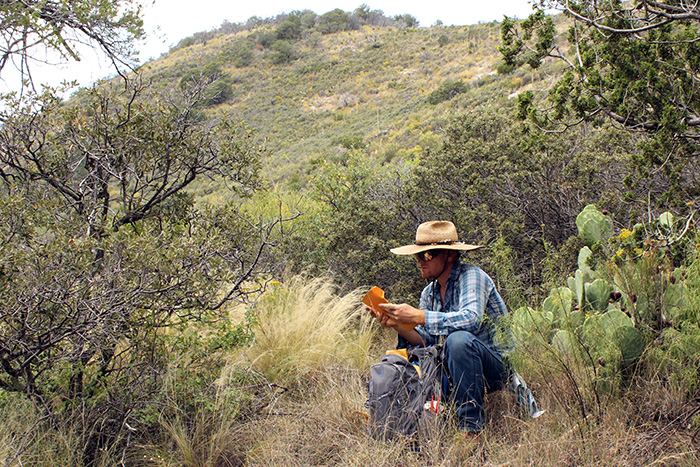Sowing Oaks

Arborist Andrew McNeil-Marshall collects acorns on a trip to West Texas to collect oak species for the Texas Arboretum. PHOTO Lacey Collins
ANDREW MCNEIL-MARSHALL IS on a mission to pique people’s interest in Texas oaks. “There is a real value in diversifying the urban forest and landscape with oaks,” says McNeil-Marshall, who became the arborist at the Wildflower Center’s Texas Arboretum in 2012. The arboretum is now on its way to giving Texas the potential to achieve that species diversity in its urban forests. It soon will feature a Texas oak collection that encompasses all 50 or so species of oaks native to Texas. The trees will be grown from acorns collected from around the state, germinated at the Center’s nursery and then planted in the arboretum.
McNeil-Marshall recounts the process and preparation that went into a weeklong collecting trip he took with the Center’s nursery manager Sean Watson in mid-September. “It’s kind of an adventure; it’s kind of a puzzle. You have to find where these trees occur and get permits to enter the property and collect acorns,” McNeil-Marshall explains.
The most recent expedition took the pair to west Texas to collect acorns from along the popular Davis Mountains Scenic Loop drive, Quitman Mountains and Franklin Mountains in El Paso. The typical collection day required driving from basecamp in Alpine to locations up to three hours away with several stops along the roadside to make collections.
“I take a GPS point if I find a tree with acorns. You really want to pull acorns off of a tree, not from the ground because those are much less viable,” says McNeil-Marshall. Acorns from the ground can be old or rotten or infested with weevil larvae. Each collected sample must include a clipping of the tree as a “voucher specimen” to later accurately identify successful saplings. The specimens will be submitted to The University of Texas at Austin’s herbarium to improve their holdings. During this last trip, the duo collected 11 different species of oaks, ranging from the large Arizona white oak (Quercus arizonica) to the highly adaptable silverleaf oak (Q. hypoleucoides) to the rare slender oak (Q. graciliformis).
The Texas Arboretum Oak Collection project is a long-term effort to establish a network with partners such as The University of Texas at Austin’s College of Natural Sciences, the Texas Forest Service and national conservation organizations for the purposes of research. McNeil-Marshall says, “The collection will ensure that we have the firsthand knowledge not only of how oaks grow but where they are.”
McNeil-Marshall is amazed by how much people want to help and be a part of this effort. He recalls one landowner who gave them one red Solo cup full of acorns from silverleaf oak. “He understands how important this project is for us now and for our children in the future,” says McNeil-Marshall. “I love the idea of coming out here when I’m 100 and sitting under the trees I planted.”

